
The Art Newspaper: The Zinda Jan and Injil districts sustained the worst of the damage. Arash Boostani, a project manager for the Aga Khan Trust for Culture (AKTC) in Afghanistan, who had visited some of the villages in those districts over the years, says many of them contained ancient vernacular architecture structures that dated back to the Safavid dynasty (16th to 18th century), with even a few surviving elements from the Ilkhanate dynasty (13th and 14th century). The populations had unique traditions of silk harvesting and building methods that had been passed from generation to generation. “There were windmills in this area that were around 600 years old … they are vertical windmills, which are truly one of a kind,” Boostani says. Meanwhile, Masjid-i Jami, a 13th-century Ghurid mosque, which was extended over the centuries under different rulers, now has numerous cracks and parts of its blue-tiled minarets have collapsed. Click here to read more (external link).

